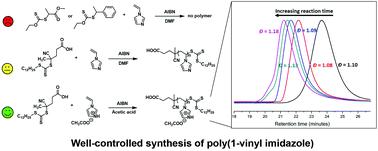当前位置:
X-MOL 学术
›
Polym. Chem.
›
论文详情
Our official English website, www.x-mol.net, welcomes your
feedback! (Note: you will need to create a separate account there.)
Facile synthesis of well-controlled poly(1-vinyl imidazole) by the RAFT process
Polymer Chemistry ( IF 4.1 ) Pub Date : 2020-07-28 , DOI: 10.1039/d0py00985g Bo Fan 1, 2, 3 , Jing Wan 1, 2, 3 , Alasdair McKay 1, 2, 3 , Zhenyuan Qu 4, 5, 6, 7 , San H. Thang 1, 2, 3
Polymer Chemistry ( IF 4.1 ) Pub Date : 2020-07-28 , DOI: 10.1039/d0py00985g Bo Fan 1, 2, 3 , Jing Wan 1, 2, 3 , Alasdair McKay 1, 2, 3 , Zhenyuan Qu 4, 5, 6, 7 , San H. Thang 1, 2, 3
Affiliation

|
Poly(vinyl imidazole)s, which contain heterocyclic aromatic rings on the polymer side chains, are of increasing interest for a wide variety of applications ranging from catalysis, polymeric ionic liquids to membrane material. However, the controlled radical polymerization of vinyl imidazoles, including 1-vinyl imidazole (1VIM), 2-vinyl imidazole (2VIM) and 4-vinyl imidazole (4VIM), proved to be extremely challenging in the past decades. Here, we demonstrate, for the first time, that well-controlled and low dispersity (Đ as low as 1.05) poly(1VIM) could be synthesized via RAFT polymerization by using acetic acid as a special solvent. Acetic acid not only works as a solvent that allows homogeneous polymerization, it also protonates 1VIM, thereby, allowing the stabilization of propagating radicals during polymerization. To verify the efficacy of the RAFT polymerization of 1VIM in acetic acid, various polymerization parameters including different RAFT agents, initiator and monomer concentrations, temperatures, etc. had been examined. Moreover, detailed kinetic studies revealed a linear, pseudo-first-order polymerization behavior of 1VIM in acetic acid, and the apparent rate constants were calculated. Furthermore, the living characteristic of this RAFT process was demonstrated by chain extension with n-butyl acrylate (nBA) and N,N-dimethyl acrylamide (DMA) to form respective block copolymers with low dispersities. Overall, the synthesis of well-controlled poly(1VIM) is expected to greatly expand the design and utility of vinyl imidazole-based materials and their applications in catalysis, membrane material, heavy metal removal, fuel cells and many other fields.
中文翻译:

通过RAFT方法轻松合成控制良好的聚(1-乙烯基咪唑)
在聚合物侧链上包含杂环芳族环的聚(乙烯基咪唑),对于从催化,聚合离子液体到膜材料的各种应用都越来越引起人们的关注。然而,在过去的几十年中,包括1-乙烯基咪唑(1VIM),2-乙烯基咪唑(2VIM)和4-乙烯基咪唑(4VIM)在内的乙烯基咪唑的受控自由基聚合被证明是极具挑战性的。这里,我们证明,对于第一次,良好控制和低分散度(Đ低至1.05)的聚(1VIM)可以合成通过通过使用乙酸作为特殊溶剂进行RAFT聚合。乙酸不仅充当允许均相聚合的溶剂,还使1VIM质子化,从而使聚合过程中的自由基稳定化。为了验证1VIM在乙酸中的RAFT聚合效果,各种聚合参数包括不同的RAFT试剂,引发剂和单体浓度,温度等。已经检查过了。此外,详细的动力学研究揭示了1VIM在乙酸中的线性,拟一级反应行为,并计算了表观速率常数。此外,通过丙烯酸正丁酯(n BA)和N,N-二甲基丙烯酰胺(DMA)形成低分散度的相应嵌段共聚物。总的来说,受控的聚(1VIM)的合成有望极大地扩展基于乙烯基咪唑的材料的设计和实用性,并将其应用于催化,膜材料,重金属去除,燃料电池和许多其他领域。
更新日期:2020-09-16
中文翻译:

通过RAFT方法轻松合成控制良好的聚(1-乙烯基咪唑)
在聚合物侧链上包含杂环芳族环的聚(乙烯基咪唑),对于从催化,聚合离子液体到膜材料的各种应用都越来越引起人们的关注。然而,在过去的几十年中,包括1-乙烯基咪唑(1VIM),2-乙烯基咪唑(2VIM)和4-乙烯基咪唑(4VIM)在内的乙烯基咪唑的受控自由基聚合被证明是极具挑战性的。这里,我们证明,对于第一次,良好控制和低分散度(Đ低至1.05)的聚(1VIM)可以合成通过通过使用乙酸作为特殊溶剂进行RAFT聚合。乙酸不仅充当允许均相聚合的溶剂,还使1VIM质子化,从而使聚合过程中的自由基稳定化。为了验证1VIM在乙酸中的RAFT聚合效果,各种聚合参数包括不同的RAFT试剂,引发剂和单体浓度,温度等。已经检查过了。此外,详细的动力学研究揭示了1VIM在乙酸中的线性,拟一级反应行为,并计算了表观速率常数。此外,通过丙烯酸正丁酯(n BA)和N,N-二甲基丙烯酰胺(DMA)形成低分散度的相应嵌段共聚物。总的来说,受控的聚(1VIM)的合成有望极大地扩展基于乙烯基咪唑的材料的设计和实用性,并将其应用于催化,膜材料,重金属去除,燃料电池和许多其他领域。











































 京公网安备 11010802027423号
京公网安备 11010802027423号